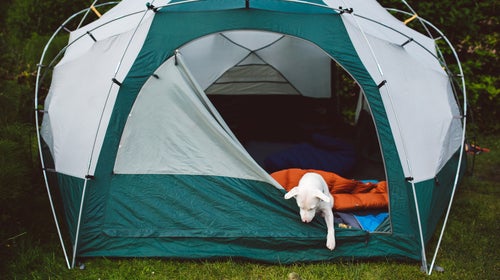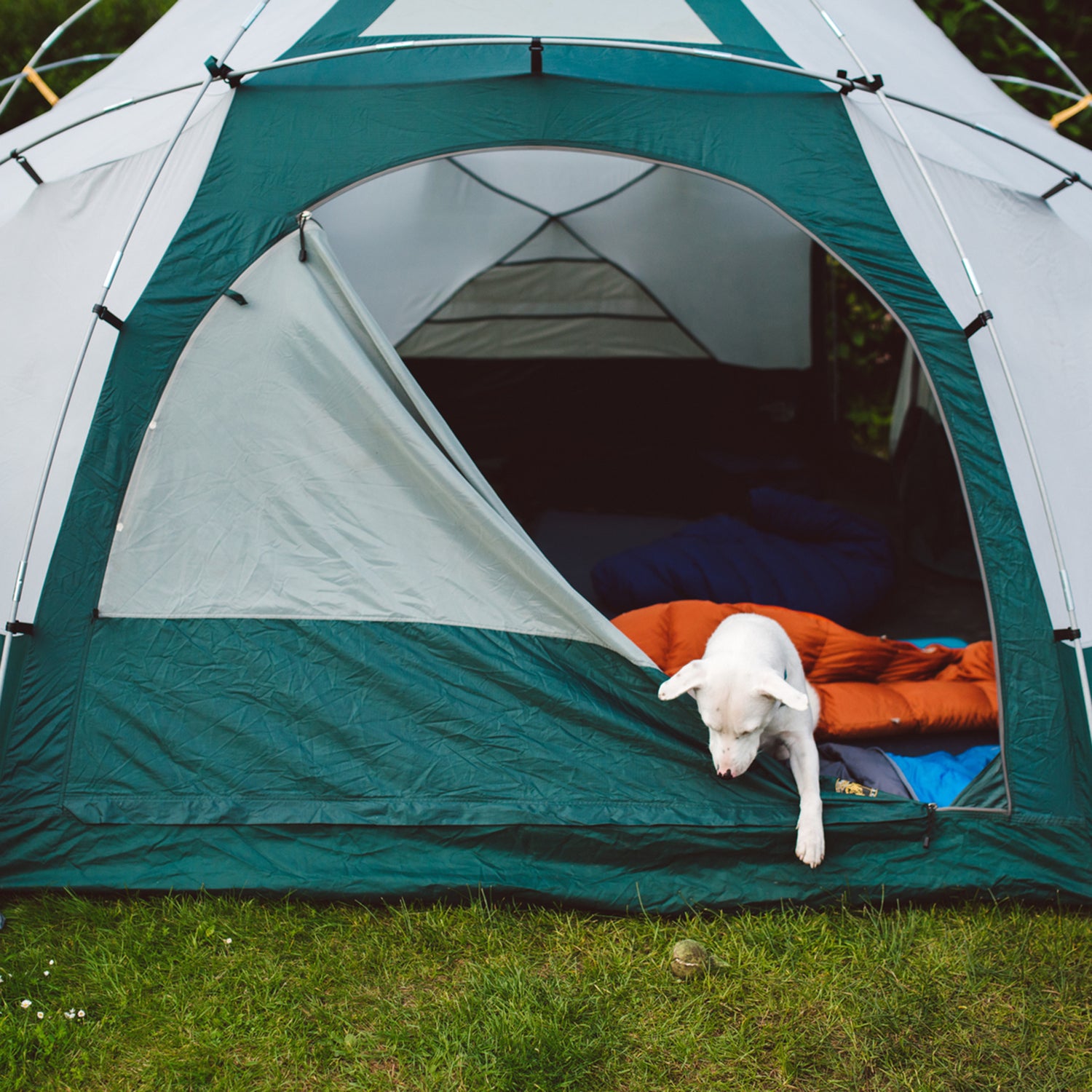Stooping in a lightweight, minimalist backpacking tent while camping out of your car isn’t much fun. Neither is getting blown over in a flimsy big-box store shelter. With that in mind, we tested 17 tents designed for car campers and families who prioritize spaciousness, convenience, and storm-worthiness over all else. These six options had us lounging in comfort and style no matter what conditions rolled through the campground.
Updated April 2025: After months of additional testing, we added four new tents, including our new top-pick, the NEMO Aurora Highrise 4. We’ve also updated info and pricing on some of our previous picks that we still highly recommend.
At a Glance
- Best Overall:
- Easiest Setup:
- Most Durable:
- Best Budget Buy:
- Most Convenient:
- Best for Glamping:
- Other Tents We Tested
- How to Choose Tents
- How We Test
- Meet Our Testers
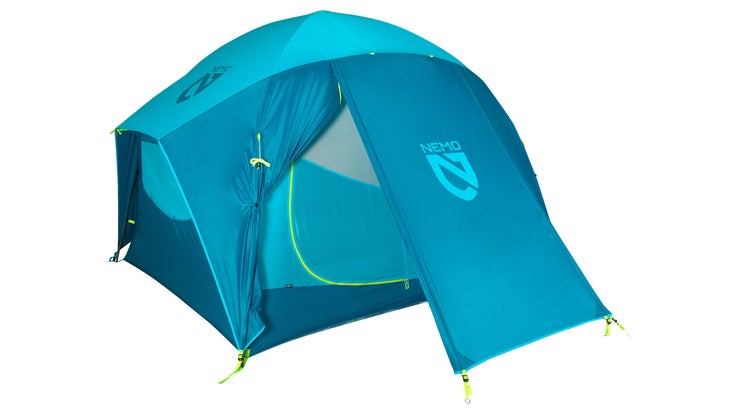
Best Overall
NEMO Aurora Highrise 4
Weight: 13.8 lbs
Peak height: 75”
Interior space: 90” x 100”
Pros and Cons
⊕ Easy setup/takedown
⊕ Effective ventilation
⊕ Spacious vestibule
⊕ High ceiling
⊗ Floor gets dirty fast
The Aurora Highrise 4 stood out in our test thanks to its supreme livability. Unlike many other four-person tents out there, this one does, in fact, comfortably house a family of four thanks to its 75-inch peak height, steep sidewalls, and two generous 19.5-square-foot vestibules.
During testing, two families of four remarked on the internal geometry, which maximizes space and freedom of movement. Its steep walls create more headroom above the 62.5-square-foot floor area than other dome tents—a 6-foot-2 tester could easily stand upright and move around freely. Two doors on either side allowed campers to enter and exit the tent without disturbing others and were tall enough that our 6-foot-2 tester didn’t have to crouch to get in and out.
With just two base poles that set up the main body of the tent and two cross poles that pitch an awning at the top, the Aurora Highrise proved easy enough for first-time campers to set up without having to look up directions. One veteran tester was able to set it up by herself in about 15 minutes. It was just as easy to break down and pack up thanks to its oversized stuff sack.
Testers who camped out in Crescent City, California during a 17-hour rainstorm applauded the tent’s waterproofing and ventilation. The hearty 68-denier polyester body material and burly 150-denier polyester floor make this freestanding tent a hoss. It proved impervious to 20 mile-per-hour wind gusts without any help from the included guylines. The PU polyester rainfly, rated to 1,2000-millimeters, boasts a structured overhang that extends six inches beyond the mesh windows, which kept the tent dry even with its two windows opened for ventilation
We loved the small details on this tent that made a big difference in comfort and convenience, like a light-diffusing pocket in the canopy for pre-bed rituals, and the slightly opaque mesh on the windows that offered shade on the hottest days but didn’t spoil views.
Our only dig on this tent is its mostly-white floor, which proved impossible to keep clean—a problem for anyone bringing kids or pets along for the ride. Overall, the Aurora Highrise 4 is a standout in the car camping category for its balance of comfort and performance at a reasonable price.
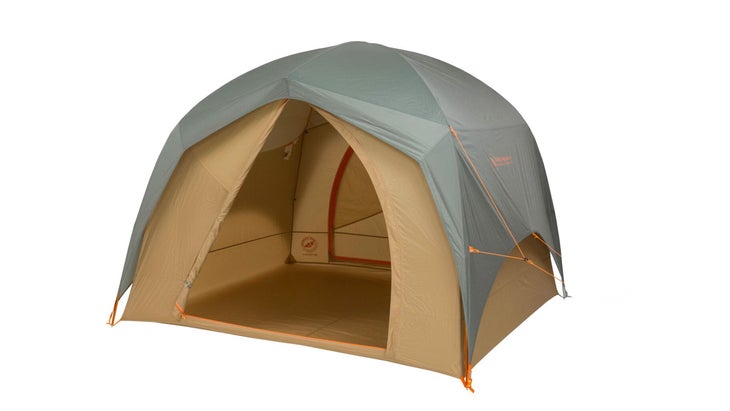
Easiest Setup
Big Agnes Big House 4
Weight: 12.6 lbs
Peak height: 70”
Interior space: 90” x 92”
Pros and Cons
⊕ Very easy setup
⊕ High ceiling
⊗ Blew heavily in high winds
⊗ Vestibule sold separately
Testers loved the Big House 4’s simplicity above all. Though big and boxy, the 90-by-92-inch tent was the easiest to set up across the category. A veteran tester was able to get the Big House 4 up on her own in under ten minutes thanks to its straightforward geometry and color-coded webbing and snaps.
With a 57-square-foot floor area, the Big House 4 is billed as a four-person tent, but testers reported that you’d need to purchase the vestibule—sold separately ($180)—to make room for four folks and all their gear, from the stuff you’d want to keep outside like mud-covered shoes to wet swimsuits.
That said, the generous 70-inch ceiling height meant our six-foot testers could stand upright and move around the interior freely. Testers also appreciated the tent’s two giant doors—spanning 80 percent of two walls—which allowed them to enter and exit the tent without crouching. Eight internal pockets were more than enough for a family of three to stash personal items like toothbrushes, phones, and headlamps.
The Big House 4 also impressed us with its waterproofing and durability. A 75-denier polyester taffeta rain fly with a 1,500mm waterproof polyurethane coating kept the tent body (made from the same material) and the interior perfectly dry through three days of rain in Crescent City, California. That hearty PU coating also appeared to reinforce the durability of the tent—it showed very little wear and tear after over three months of testing.
Our only gripe: The tent’s height proved suboptimal in high winds. Even when secured with its guy lines, the tent blew heavily in 25-mile-per-hour winds.
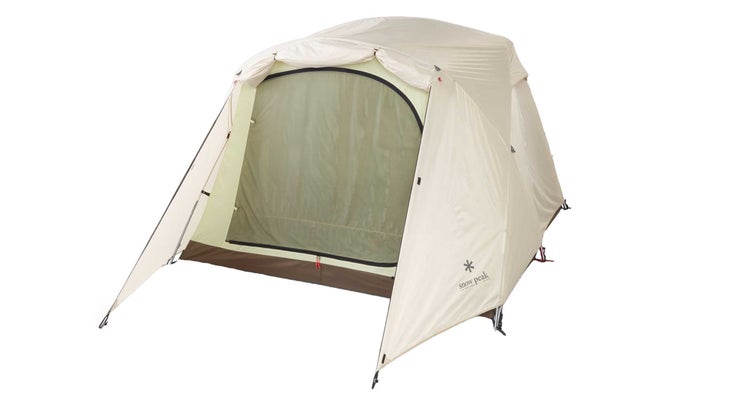
Most Durable
Snow Peak Alpha Breeze
Weight: 24.2 lbs
Peak Height: 73″
Interior Space: 109″ x 102″
Pros and Cons
⊕ Four points of entry
⊕ Excellent ventilation
⊕ Durable
⊗ Heavy
The Alpha Breeze showcases Snowpeak’s emphasis on designing elegant, simple products with a decidedly luxurious fee. The top-tier materials—in this case, polyester fabric and duralumin poles—are strong and functional, and durable enough to stay that way for quite a while.
The extra-thick copper-aluminum poles gave us confidence when a sustained 15 mph wind picked up during an overnight on Camano Island in Washington. The structure barely flinched under the gusts, and the forearm-length Douglas fir boughs they knocked down onto our campsite. The 75-denier, DWR-treated polyester taffeta rain fly and 300-denier polyester tent floor both looked brand-new after two dusty, rocky trips in Montana’s Bitterroot Mountains.
Besides the fact that it felt indestructible, Seattle-based tester Maeve Axtell loved the boxy tent’s four doors, with one on each side. “It was easy to get in and out without disturbing other people sleeping in the tent, and when it got warm we could get cross-breezes from every direction,” said Axtell. The tent’s high ceiling and two mesh-covered “windows” on opposite walls contributed to the spacious feeling inside that the four doors created, although all those openings only left space for four mesh pockets and 10 loops to stash small essentials inside.
All good things come at a cost, though, and with the Alpha Breeze, the cost is weight. Despite its heft, it’s not excessively bulky and doesn’t take up an unreasonable amount of trunk real estate. Another ding? It’s not especially easy to set up: and the tent’s 6-plus-foot height makes the Breeze a tad unwieldy to pitch. Testers ultimately forgave those shortcomings, since both features made for a rock-solid pitch and roomy, comfortable interior.
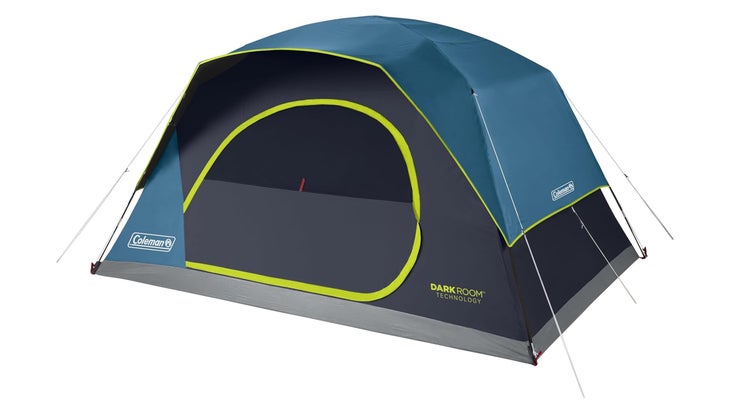
Best Budget Buy
Coleman 8-Person Darkroom Skydome
Weight: 21.6 lbs
Peak height: 68”
Interior Space: 12’ x 9’
Pros and Cons
⊕ Great price
⊕ Blocks sunlight
⊗ Poor wind performance
At $230, the eight-person Darkroom Skydome costs less than half what other popular eight-person tents cost (like The North Face Wawona 8 and Big Agnes Bunk House 8), making it a great entry-level option for families. You don’t get the same high-performance materials with that price, but for casual frontcountry camp trips in mild temperatures and weather, the Darkroom Skydome gets the job done.
Besides the price and easy setup, the tent’s light-blocking fabric is what made this tent stand out, especially for folks with little kids. Coleman uses a dark-coated polyester on the rain fly and inner panels of the Skydome to block out 90 percent more light than the brand’s normal car-camping tents. Besides creating ideal sleeping and napping conditions even when the sun is still up, the dark fabric also helps keep the interior cool during the day.
While inexpensive tents don’t always have the best track record in terms of durability and weatherproofing, the Darkroom Skydome proved surprisingly robust for a budget option. After over a dozen days in the rain, testers gave its 300-millimeter-rated polyurethane rainfly high scores for waterproofing in spite of the low rating. One tester used it for over 30 nights—including on three different rafting trips, which are notoriously rough on tents because they’re exposed to the elements not only when they’re pitched, but also while being transported on the water. It held up admirably to rain and rough pack jobs until sustained 20 mile-per-hour wind gusts snapped one of the two aluminum poles.
At 68-inches tall, it’s slightly shorter than the other tents on this list. That made it easier to pitch—setup was incredibly simple despite its massive footprint—but didn’t offer the same generous standing height. Testers taller than 5’10” had to crouch significantly in the tent. And like many large-capacity tents, this “eight person” shelter is stretching it with six occupants.
It’s not our pick for seasoned campers who head out into the wild no matter the weather, but for families with young kids and the budget-conscious, the Darkroom Skydome is a smart buy.
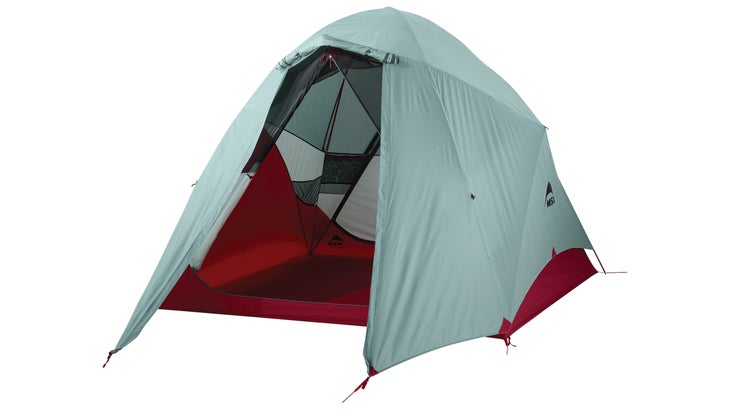
Most Convenient
MSR Habiscape 4P
Weight: 12.7 lbs
Peak Height: 73″
Interior Space: 95″ x 95″
Pros and Cons
⊕ Lots of livable space
⊕ Highly weatherproof
⊗ Mediocre ventilation
There’s a lot we liked about the Habiscape, from the generous elbow room (86 square feet including the vestibule) to the ample standing height (73 inches), but it was a dual-sided pocket that hooked us. Next to the door MSR built in something they call a “pass-thru pocket”—a bug mesh-lined portal that’s accessible from both inside and out. Without opening the door, testers could reach through to grab car keys, bug spray or a headlamp. “It seems like a little thing, but the convenience was huge,” says Chris Baikie, a British Columbia-based tester. “There were definitely fewer bugs in the tent because of it.”
Set-up for the Habiscape requires two people, but the asymmetric design and color-coding helped make it quick and easy. The dome structure and low-hanging 68-denier polyester fly stood up to a 20 mile-per-hour windstorm with little flapping. The rest of the tent is equally tough, with the same 68-denier poly on the floor, 40-denier ripstop nylon walls, and 7000 series aluminum tent poles.
We had to duck under the vestibule door to get inside, but it provided enough room for a cooler and gear, and kept drips out of the tent during rainstorms. A second door came in handy for frequent nighttime bathroom excursions. The Habiscape packs down easily, and ends up smaller than many tents of its size, at roughly nine inches by two feet. “It’s almost perfect,” says lead tester Ryan Stuart. “And it’s not even that heavy.”
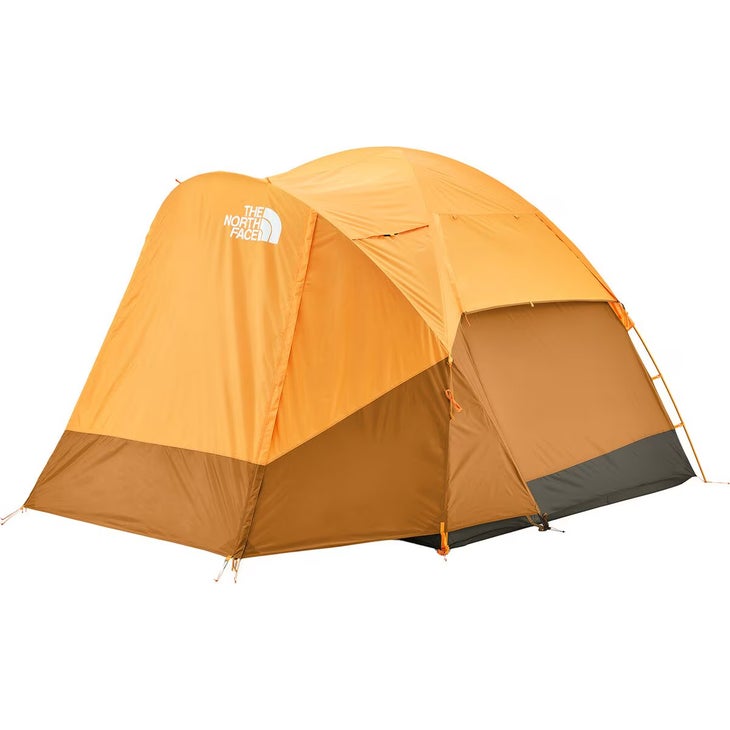
Paid Advertisement by Backcountry.com
The North Face Wawona 4 Tent: 4-Person 3-Season
Set up more than just a place to sleep—set up a basecamp for adventure. The North Face Wawona 4 Tent delivers just that with enough room to stand up inside, stash all your gear, and even set up a cozy lounge area. The extended front vestibule keeps gear organized and protected, while large mesh windows and a top vent ensure you stay cool on warm nights. Sturdy DAC poles and a waterproof fly provide confidence in unpredictable weather, and an easy-pitch design means you can pack up in no time.
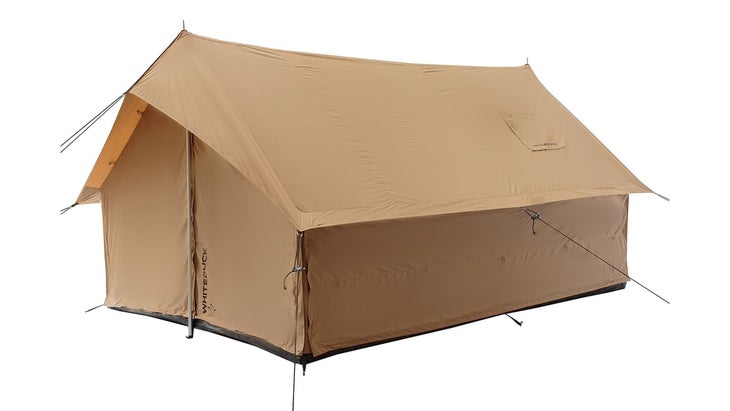
Best for Glamping
White Duck Outdoors Rover Scout Tent
Weight: 62 lbs
Peak Height: 84”
Interior Space: 8’ x 13’
Pros and Cons
⊕ Durable materials
⊕ Very weather-resistant
⊗ Complicated setup
⊗ Heavy
Tester Saylor Fleet, a longtime wall tent lover who used the previous version of the Rover Scout Tent for over a decade, likened this updated model to a sprinter van. “It’s big enough to stand up in, sleep in, and cook in,” he said. Heck, this 8-by-13-foot tent is essentially a canvas-sided cabin that easily sleeps six adults. Its size and sturdiness make it ideal for families or hunters looking to set up a basecamp for extended stints in the backcountry.
During testing, we set up a luxury camping situation for two adult testers with individual cots and a small kitchen—including a Coleman stove, dishware, and a small wash bin on a roll-a-table—and still had plenty of space to walk around.
But the Rover Scout isn’t just for those who like to spread out; it’s also got performance chops. Testers appreciated how well the Dynatek cotton and recycled polyester canvas held onto heat on a night in the low 40s on the Klamath River in Oregon. On the flip side, they liked that they could easily roll up the two doors and two walls of the tent to dump heat when temps rose into the mid 70s during the day.
Unlike car-camping-oriented tents with traditional pole structures, the Rover Scout necessitates the use of guy-outs to stay upright and storm-worthy. You have to be selective about your site because you have to be able to drive stakes in the ground to firmly secure those guy-outs—you’ll have a tough time pitching this tent on loose sand and bedrock.
While it took a while for two testers to hunt down an ideal site—and a good 30-minutes to erect—once it was up, it wasn’t going anywhere. Category managerJoe Jackson pitched it on the Klamath River in the fall and left it up for two weeks between camping stints. During that time, it saw four days of rain and wind gusts of over 30 miles-per-hour, yet Jackson returned to find it unscathed and fully dry after his time away.
White Duck’s canvas not only proved durable, but it avoided the achilles heel of canvas tents: It did not get covered in mildew when it was put away slightly wet. The downside to the Rover Scout’s design? While the canvas is lighter than that of wall tents we’ve tested in the past, the aluminum and steel frame is heavy: At 62 pounds, it was too heavy for our smaller testers to handle on their own.
That said, it packs down to roughly the size of a couch cushion, compact enough to fit into the back of a Honda Element with room left over for camp supplies.
Other Tents We Tested
- : We used this as a base camp for a raft guide weekend. We loved it as a communal shelter but found it too large and expensive for most campers.
- : This tent really did pop up in under 30-seconds thanks to a two-handled ripcord that erects the tent from the top. Ultimately, it’s too small for most recreational campers.
- : The Fernweh felt like a member of the Jackson family at the end of three summers of testing because of how comfortably the massive living space accommodated months of family camping. But it takes two adults over an hour to set up properly, even with practice.
How to Choose a Camping Tent
Size and Dimensions
Start with the number of people who will be sleeping in the tent and add at least one. No one ever complained about a little extra elbow room, and ultra-wide camping pads often need extra space. Next, consider packability: If you have limited storage or trunk space, a more packable option will make jamming it between all of the coolers and propane easier. Height is crucial, but comes with a tradeoff: Being able to stand up to get dressed or stretch your legs is nice, but means it will be harder to set up, especially if you’re doing it solo.
Feature Set
Look for ample pockets for staying organized, big vestibules and/or high bathtub walls that protect the interior from blowing rain, multiple venting options, and roomy doors. Of course, a tent’s principal job is to protect you from the elements, so weatherproofing should be a primary consideration. A fly that reaches to the ground provides the most coverage, but can also limit venting, making for uncomfortably stuffy conditions when it’s hot. A tall pole structure is susceptible to high winds, so make sure the tent has plenty of guy-out points for stabilizing and protecting the tent from gusts.
Budget
Price is always important, but try to prioritize value. Spending a bit more for a tent with more durable materials, like higher denier fabrics and burly aluminum poles, will save you money in the long run. You can find a no frills, serviceable four-person summer tent in the $200 range, with waterproofing, durability, and reparability generally improving as you start getting into higher price ranges.
But if you’re looking for a tent to use three seasons of the year, that you expect to get a lot of use in stormy weather, or that you’d like to use for the rest of your life, we recommend budgeting between $350 and $600. That’s the cost of more reliable construction and waterproofing—which, as all of our testers who have woken up to puddles inside their tents can tell you, is priceless when you really need it.
How We Test
- Tents tested: 17
- Number of nights camped: 50+
- Number of testers: 17
- States tested in: California, Oregon, Washington
For this test, we mainly considered four- to eight-person, three-season tents because they tend to be the best fit for most car campers who prioritize comfort and space over weight and packability. When all was said and done, our crew of 17 testers tested 17 tents—newer options on the market as well as some perennial favorites—to find the best for frontcountry campers.
We tested these tents in the beaches, rivers, and mountains of California, Oregon, and Washington from September through November. Conditions included everything from sub-freezing temps and sustained rainstorms to blazing hot rafting trips on the Klamath River in Northern California.
After a number of weekend camping trips, testing concluded with a month-long field-testing stint in Crescent City, California, to whittle down the final contenders. Testers included four families with kids ranging in age from two to eleven, and parents in their early thirties to their mid fifties. Some were first-time campers, while others could measure the amount of time they’ve spent in years.
We asked all testers to evaluate tents on their functionality, ease of setup and take-down, standout features, and overall comfort and livability.
Meet Our Testers
Joe Jackson has been professionally testing gear for �����ԹϺ��� for over a decade and has pitched and slept in over 90 tents during that time. While he is proud of the breadth of tents he has tested for this publication, his biggest flex is that he lived out of an in Oregon for eight months.
Miyo McGinn is a former assistant editor at �����ԹϺ��� based in Bozeman, Montana. She has camped in a dozen different states and four continents, but Washington state, where she grew up, will always be her favorite place to pitch a tent. McGinn got her start reviewing gear as �����ԹϺ���’s gear editorial assistant in 2021.
More Gear Reviews
The Best Sleeping Bags for Car Campers
The Best Sleeping Pads of 2025
The Best Backpacks, Duffels, and Roller Bags for �����ԹϺ��� Travel
